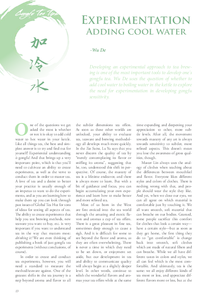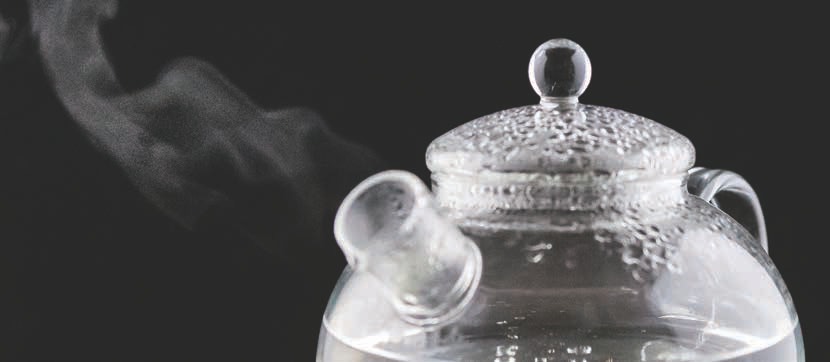
 |
|
加冷水
One of the questions we get asked the most is whether or not it is okay to add cold water to hot water in your kettle. Like all things tea, the best and simplest answer is to try and find out for yourself! Experiential understanding is gongfu! And that brings up a very important point, which is that you'll need to cultivate an ability to create experiments, as well as the verve to conduct them in order to master tea. A love of tea and a desire to better your practice is usually enough of an impetus to want to do the experiments, and as you are learning how to make them up you can look through past issues of Global Tea Hut for tons of ideas for testing all aspects of tea. The ability to create experiments that help you test brewing methods, new teaware you want to buy, etc. is very important if you want to understand tea in the way that matters most: drinking it! We are even thinking of publishing a book of just gongfu tea experiments (without conclusions, of course).
In order to create and conduct tea experiments, however, you will need a standard to measure the method/teaware against. One of the greatest shifts in the tea journey is a step beyond aroma and flavor to all the subtler dimensions tea offers. As soon as these other worlds are unlocked, your ability to evaluate tea, teaware and brewing methodology all develops much more quickly. In the Tea Sutra, Lu Yu says that you never discern the quality of tea by "merely contemplating its flavor or sniffing its aroma", suggesting that he, too, understood this shift in perspective. Of course, the mastery of tea is a lifetime endeavor, and there is always more to learn. But with a bit of guidance and focus, you can begin accumulating your own experience and learn how to make better and more refined tea.
Most of us born in the West are first enticed into the tea world through the amazing and exotic flavors and aromas a cup of tea offers. There is a great pleasure in fine tea, sometimes deep enough to cause a sigh. And it is difficult for some to see beyond the flavor and aroma, as they are often overwhelming. There is never a time in which they need to be set down, or enjoyment set aside, but our development in tea and ability to communicate quality will always begin at a slightly deeper level. In other words, continue to relish the wonderful flavors and aromas your tea offers while at the same time expanding and deepening your appreciation to other, more subtle levels. After all, the movement towards mastery of any art is always towards sensitivity to subtler, more refined aspects. This doesn't mean you lose the awareness of gross qualities, though.
Master Lin always uses the analogy of clothes when teaching about the differences between mouthfeel and flavor. Everyone likes different styles and colors of clothes. There is nothing wrong with that, and people should wear the style they like. And yet, when we close our eyes, we can all agree on which material is comfortable just by touching it. We all want smooth, soft material that can breathe on our bodies. Granted, some people sacrifice this comfort for clothes that look a certain way - have a certain style - but as soon as they get home, the first thing they do to "get comfortable" is change back into smooth, soft clothes which are made of natural fibers and can breathe. While we all have different tastes in colors and styles, we all can feel which is the most comfortable. And ultimately, tea is the same: we all enjoy different kinds of tea more or less, and appreciate different flavors more or less, but at the same time when it comes to the texture - the mouthfeel - of a tea, we all want it to be smooth.
Start paying attention to the way the tea touches your mouth and throat. Is it smooth or rough? We have found that the best teas are very smooth and comfortable. As soon as they enter the mouth, they splash up to the upper palate. The swallowing should occur naturally. With the finest teas, it's as if the tea goes down on its own, without any conscious energy in the swallowing. The best teas have a tendency to slide back on their own. They "want" to go down, in other words. Lower-quality teas, on the other hand, have a tendency to pool in the front of the mouth, and you have to consciously push them to the back of the mouth and then consciously swallow them as well.
Master Lin also says that the best teas coat the mouth like milk or oil, so that after you swallow, you can feel the tea everywhere in your mouth - and an aroma that slowly rises up into your nasal cavity. The tea should also be comfortable in the throat, often lingering on the breath for some time. This splashing up to the upper palate, traveling down smoothly, leaving the mouth moist and coated, as well as lingering on the breath are all signs of a fine tea. The more of these characteristics a tea has, the more comfortable it will be in your mouth.
As you move towards subtler and subtler aspects of tea, you find that after mouthfeel there are other levels as well, including the Qi of the tea. There is of course more to mouthfeel than what we have introduced here, but just the shift in focus away from flavor and aroma, to include these subtler levels will be a huge leap in your ability to appreciate tea, and ultimately prepare better cups for others, which is what gongfu tea is really all about...
Now you have all the three things you need to practically and experientially improve your gongfu brewing skills: 1) an ability to create experiments that matter to you, which you can learn from reading this section of Global Tea Hut now and through past issues; 2) a standard to use in evaluating methods/teaware; and 3) an enthusiasm to practice, learn and grow. This last one should never leave your side. Zen mind is the beginner's mind, and we can always improve! And with these three we can turn to the issue of adding cool/cold water to a kettle with hot water in it...
This is a confusing topic, like many aspects of tea brewing, since different teachers, websites, shops will suggest opposite aspects of this. In the Japanese tea ceremony, a spoutless kettle called a "kama" is used, which means that cold water must be added to the hot water since it would be difficult to dump out the remaining water at the bottom. Some gongfu tea brewers have suggested that this "refreshes" the water. Others say it destroys the structure of the water by shocking it. They suggest that the different energies of the water conflict, which makes tea rough. Here at the Hut, we suggest trying it out yourself, of course!
A simpler version of this month's experiment is done with a kettle, pot and two identical cups and a glass/pitcher of cold water. Start by filling your kettle about a third full. You want less water because time will be of the essence. Bring the water to boil and fill the first cup. Quickly add some cold water from the pitcher/glass to the boiling water and let it come back up to a second boil. Then, pour this water into the second cup. Try tasting the water back and forth from cup to cup, comparing the mouthfeel to see which is better. You can then repeat this experiment by steeping a tea with each of these waters. A more advanced version would be to use two kettles and burners simultaneously, and maybe even two identical teapots. As always, write into us at globalteahut@gmail.com, or add to our Discussion board under the Connect dropdown menu on the GTH website. I'd love to hear your results and I'll gladly share mine with you!
